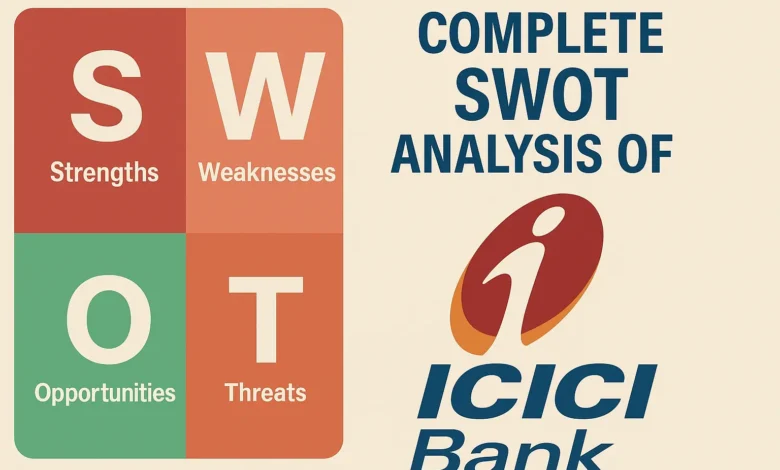Complete SWOT Analysis of ICICI Bank – Inside the Strategy of India’s Leading Private Bank
Discover the complete SWOT analysis of ICICI Bank. Explore its strategy, digital growth, strengths, and market position as India’s top private bank in 2025

In India’s fast-evolving banking landscape, ICICI Bank has emerged as a frontrunner—not just as a financial institution but as a technology-driven innovator.
From pioneering digital banking services to offering seamless financial solutions across segments, ICICI has continually adapted to the changing demands of both individual and corporate customers.
Over the years, the bank has built a robust foundation in retail, corporate, and international banking, and has earned its reputation as one of India’s most reliable and forward-looking private sector banks.
But in a competitive environment filled with PSU giants, nimble fintechs, and fellow private contenders like HDFC and Axis Bank—how does ICICI Bank maintain its edge?
This article presents a detailed SWOT analysis of ICICI Bank, exploring the bank’s Strengths, Weaknesses, Opportunities, and Threats. Whether you’re a student, investor, professional, or just curious about the Indian banking sector, this breakdown will offer valuable insights into ICICI’s business strategy and future potential.
Also read: In-Depth SWOT Analysis of Axis Bank – India’s Leading Private Sector Bank
Company Overview – About ICICI Bank
ICICI Bank (Industrial Credit and Investment Corporation of India) is one of India’s largest and most influential private sector banks. Established in 1994 as a commercial bank, it was promoted by the original ICICI Ltd., which later merged with the bank in 2002 to unify their financial services offerings.
Headquartered in Mumbai, ICICI Bank today serves millions of retail and corporate customers across the country. It operates through an extensive network of:
- 6,000+ branches
- 16,000+ ATMs
- And a highly adopted digital banking ecosystem
ICICI offers a wide array of financial services, including retail banking, corporate & investment banking, insurance, asset management, NRI banking, and digital loans. Its subsidiaries like ICICI Prudential Life Insurance and ICICI Securities further strengthen its presence in India’s financial ecosystem.
Known for its technology-first approach, ICICI Bank has been a pioneer in offering end-to-end digital solutions, including iMobile Pay, Instant Loans, Contactless Banking, and AI-powered support—cementing its status as a trusted leader in India’s digital banking revolution.
What is SWOT Analysis?
A SWOT analysis is a powerful business tool used to assess an organization’s current position in the market by examining four key dimensions:
- S – Strengths: What internal advantages does the company have?
- W – Weaknesses: What internal limitations could affect its growth?
- O – Opportunities: What external trends or market openings can the company leverage?
- T – Threats: What external risks or challenges could harm its progress?
For a complex and highly regulated industry like banking, a SWOT analysis is essential in understanding how financial institutions like ICICI Bank respond to market shifts, policy changes, technological evolution, and competitive pressures.
This analysis helps evaluate how ICICI Bank is positioned to capitalize on opportunities like digital banking and rural penetration, while also identifying risks such as cybersecurity threats, economic fluctuations, and growing fintech disruption.
also read: In-Depth SWOT Analysis of Axis Bank – India’s Leading Private Sector Bank
ICICI Bank’s Strengths
ICICI Bank’s strong market presence and consistent performance over the years are the result of a carefully crafted mix of strategic innovation, operational efficiency, and customer-centric services. Let’s explore the key strengths that fuel its competitive edge:
1. Strong Retail & Corporate Banking Presence
ICICI Bank has built a well-balanced portfolio across retail and corporate banking. It is a leader in segments like home loans, personal finance, credit cards, and SME lending. With over 6,000 branches and 16,000+ ATMs, it has established an extensive physical footprint across India, making its services easily accessible to millions.
2. Digital Banking Leadership
The bank has consistently been a pioneer in digital transformation. Its flagship app iMobile Pay offers seamless transactions, loans, investments, and insurance services—all in one place.
Innovations like Insta Loans, digital account opening, and AI-based customer support have positioned ICICI as a tech-first bank trusted by the younger, digital-savvy audience.
3. Robust Asset Quality and Financial Stability
ICICI Bank has improved its asset quality over the years by reducing non-performing assets (NPAs) and strengthening its risk control mechanisms. It maintains a healthy capital adequacy ratio (CAR) and continues to deliver strong profit growth, reinforcing investor and depositor confidence.
4. Diversified Revenue Streams
The bank earns not only from interest income but also from fee-based services, treasury operations, insurance, and mutual funds. This diversified model ensures stability even during credit cycle slowdowns or regulatory changes in any one segment.
5. Strong Brand Value & Public Trust
ICICI Bank enjoys high brand recognition and trust among Indian consumers. Its long-standing presence, customer service quality, and association with financial inclusion initiatives like Jan Dhan Yojana and PMAY (Pradhan Mantri Awas Yojana) boost its credibility.
6. Focus on Financial Inclusion & Rural Banking
Through Business Correspondent models, rural ATMs, and simplified account products, ICICI has contributed significantly to bringing banking services to underserved areas, supporting the government’s goal of a financially inclusive India.
These strengths have positioned ICICI Bank not only as a leader in India’s private banking space but also as a trailblazer in digital and inclusive banking—laying a solid foundation for future growth.
ICICI Bank’s Weaknesses
Despite its many strengths, ICICI Bank faces certain internal challenges that could slow its momentum or expose it to strategic risks if left unaddressed. Here are some key areas of concern:
1. Past Governance & Reputation Issues
The bank faced reputational setbacks in recent years, particularly around the Chanda Kochhar controversy, which raised concerns about corporate governance and transparency.
Although leadership changes and reforms have been made, such incidents still linger in public memory and may impact stakeholder trust.
2. Urban-Centric Focus
ICICI’s stronghold lies in Tier I cities and metros, while rural and semi-urban market penetration remains weaker compared to PSU banks like SBI or Bank of Baroda. This limits its ability to tap into the next wave of financial inclusion and deposit growth from underserved regions.
3. Limited Global Footprint
Compared to some peers and multinational banks, ICICI Bank has a modest international presence. This restricts its global expansion potential and limits access to diversified foreign income streams—especially in emerging diaspora-driven markets.
4. High Dependence on Retail Lending
A large chunk of ICICI’s revenue comes from retail loans, such as personal loans, credit cards, and home loans. During economic downturns or rising interest rate cycles, retail borrowers are more prone to default—posing risks to asset quality.
5. Operational Risks from Rapid Digitization
While digital leadership is a strength, it also introduces higher cybersecurity risks, data privacy concerns, and technical failures. Managing these risks is crucial to sustaining consumer confidence and service reliability in a digital-first environment.
These weaknesses don’t negate ICICI Bank’s overall performance but do highlight areas that require strategic attention and ongoing risk mitigation to ensure consistent and sustainable growth.
ICICI Bank’s Opportunities
As India’s financial ecosystem grows more sophisticated and digital-first, ICICI Bank stands at the forefront of multiple high-potential opportunities. By leveraging these, the bank can expand its reach, diversify income, and reinforce its position as a future-ready institution.
1. Digital Banking Boom in India
With UPI, mobile wallets, and digital banking seeing explosive growth, ICICI can further enhance its tech offerings. Products like instant savings accounts, paperless loans, and investment apps can help tap into younger, mobile-first consumers across urban and rural areas alike.
2. Expansion in Rural & Semi-Urban Markets
India’s next wave of banking growth is in Tier II, Tier III, and rural regions. ICICI can scale its microfinance, agri-loans, and Jan Dhan accounts, while using its digital infrastructure to reduce operational costs and serve these high-potential markets effectively.
3. Cross-Selling to a Large Customer Base
With millions of retail and SME customers, ICICI has immense scope to increase revenue per user by cross-selling insurance, mutual funds, gold loans, and investment products. Bundled offerings for salaried professionals, students, and small business owners can drive wallet share.
4. Fintech Collaboration & Ecosystem Play
Instead of competing with fintechs, ICICI can partner with or acquire startups to deliver innovative services. API banking, BNPL (Buy Now Pay Later), and co-branded credit cards can unlock new user segments and monetization models.
5. Green & Sustainable Banking Initiatives
With ESG investing on the rise, ICICI can position itself as a leader in green finance by launching green bonds, sustainable lending products, and carbon-neutral initiatives. This will enhance its image among responsible investors and future-focused customers.
These opportunities offer ICICI Bank a powerful chance to not only grow, but also lead the transformation of India’s financial future, especially by bridging the gap between technology, trust, and inclusion.
ICICI Bank’s Threats
While ICICI Bank is a leader in private sector banking, it operates in a volatile and highly regulated environment. Various external factors—economic, competitive, and technological—can pose serious risks to its operations, profitability, and reputation.
1. Intense Industry Competition
ICICI faces stiff competition from both established private sector banks like HDFC, Axis, and Kotak, and from public sector banks that are now ramping up digital transformation.
Additionally, fintech startups and payment banks are capturing market share in niche areas like UPI, micro-lending, and digital wallets.
2. Regulatory & Policy Risks
Banking in India is heavily governed by the Reserve Bank of India (RBI). Any change in regulations around lending norms, capital requirements, KYC policies, or data privacy laws can affect ICICI’s flexibility and operations. Unexpected penalties or compliance failures can also damage reputation.
3. Economic Slowdowns & Credit Risk
In the event of recession, high inflation, or interest rate hikes, consumers and businesses may struggle to repay loans—leading to a rise in NPAs (Non-Performing Assets). Since ICICI relies heavily on retail lending, it is particularly vulnerable during such downturns.
4. Cybersecurity Threats & Fraud
As ICICI continues to digitize, it becomes increasingly vulnerable to cyberattacks, phishing scams, and data breaches. A major security lapse could not only cause financial loss but also erode consumer trust in its digital platforms.
5. Global Uncertainties
ICICI’s performance is also influenced by global factors like geopolitical tensions, oil price volatility, foreign investment flows, and currency fluctuations. These can affect stock prices, foreign exchange operations, and investor confidence in the short to medium term.
To remain resilient, ICICI Bank will need to continuously monitor these external threats, strengthen its risk management frameworks, and maintain agility in a changing macro and regulatory environment.
Competitive Strategy & Future Outlook
ICICI Bank’s growth journey is a blend of digital transformation, customer-centricity, and risk-conscious expansion. As India’s financial sector becomes more competitive and tech-driven, ICICI is doubling down on a few key strategic pillars:
1. Tech-Led Banking Innovation
ICICI continues to lead in digital banking with platforms like iMobile Pay, Instabanking, and API banking solutions. Its focus on AI, data analytics, and automation is helping streamline operations, detect fraud, and personalize offerings for millions of customers.
2. Rural & Semi-Urban Penetration
By expanding its Business Correspondent (BC) model and improving last-mile connectivity through digital kiosks and mobile banking vans, ICICI is actively pushing into Tier II, Tier III, and rural markets—a massive untapped segment for deposits, savings, and agri-finance.
3. Ecosystem Banking & Cross-Selling
ICICI is building customer ecosystems—offering bundled products across insurance, mutual funds, loans, and investments under one umbrella. This enhances lifetime customer value and improves retention through convenience and trust.
4. ESG & Sustainable Finance Focus
Recognizing the global push toward ethical business, ICICI is stepping into green lending, ESG-compliant investments, and carbon-neutral operations. This forward-looking approach will attract conscious investors and elevate its long-term brand value.
5. Prudent Risk & NPA Management
Post its past challenges, the bank has strengthened its credit appraisal systems, invested in predictive analytics, and created a healthier loan book—ensuring future growth is backed by financial discipline.
Future Outlook
ICICI Bank is on track to become not just a leader in Indian banking, but a benchmark for digital-first, inclusive, and sustainable banking in Asia. Its ability to adapt quickly, invest in tech, and balance growth with governance will determine how strongly it continues to outperform its peers in the years ahead.
Conclusion & Final Thoughts
ICICI Bank has earned its position as one of India’s most respected and innovative private sector banks through a well-balanced mix of technology, financial prudence, and customer trust.
With strengths like a robust retail presence, cutting-edge digital platforms, and a diversified product portfolio, the bank is well-equipped to meet the evolving demands of a fast-changing financial ecosystem.
However, it isn’t without challenges. Issues like rising competition, regulatory risks, and cybersecurity threats underscore the need for constant vigilance and strategic evolution. Fortunately, ICICI’s focus on digital transformation, rural market penetration, ESG initiatives, and risk management position it to navigate these threats effectively.
This SWOT analysis reveals that ICICI Bank’s real strength lies in its ability to adapt—balancing scale with innovation, speed with security, and growth with governance. If it stays on this path, ICICI won’t just continue leading India’s banking sector—it will help define its future.





